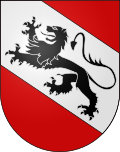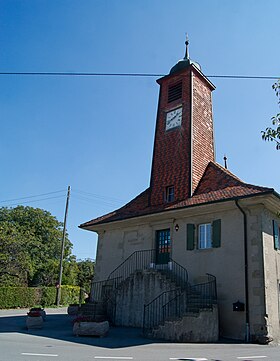Bottens
| Bottens | |
|---|---|
| State : |
|
| Canton : |
|
| District : | Gros-de-Vaud |
| BFS no. : | 5514 |
| Postal code : | 1041 |
| Coordinates : | 540379 / 163152 |
| Height : | 730 m above sea level M. |
| Height range : | 625–848 m above sea level M. |
| Area : | 6.88 km² |
| Residents: | 1297 (December 31, 2018) |
| Population density : | 189 inhabitants per km² |
| Website: | www.bottens.ch |
|
Bottens parish hall |
|
| Location of the municipality | |
Bottens is a municipality in the Gros-de-Vaud district in the canton of Vaud in Switzerland .
geography
Bottens is 730 m above sea level. M. , 3 km southeast of Echallens and 12 km north of the canton capital of Lausanne (as the crow flies). The village extends on a high plateau east of the Talent , in the eastern Gros de Vaud , on the north-western edge of the heights of the Jorat , in the Vaudois Central Plateau .
The area of the 6.8 km² municipal area covers a section of the high plateau in the central Vaudois plateau. The western boundary is the Tal des Talent, to which the Posat and Combron streams flow from Bottens . The south-western border runs in the wooded valley of the latter. To the east, the municipality extends over the Bottens plateau, the Planche Riande forest height ( 783 m above sea level ) and the headwaters of the Coruz (in the catchment area of the Mentue ) to the height of La Carnacière , at 848 m above sea level. M. the highest elevation of Bottens is reached. In 1997, 7% of the municipal area was accounted for by settlements, 19% for forests and trees and 74% for agriculture.
The farm settlements Chalet Curial ( 755 m above sea level ) south of the Planche Riande, Mandou ( 753 m above sea level ) in the headwaters of the Coruz, Grands Troncs ( 830 m above sea level ) on the high plateau of the Jorat and belong to Bottens numerous individual farms. Neighboring municipalities of Bottens are Echallens , Poliez-le-Grand , Poliez-Pittet , Froideville , Lausanne , Bretigny-sur-Morrens and Assens .
population
With 1297 inhabitants (as of December 31, 2018) Bottens is one of the smaller communities in the canton of Vaud. 93.0% of the residents are French-speaking, 3.3% German-speaking and 1.2% Portuguese-speaking (as of 2000). The population of Bottens was 464 in 1850 and 422 in 1900. A rapid population increase has been observed since 1970 (424 inhabitants), with the number of inhabitants doubling within 40 years.
economy
Until the middle of the 20th century, Bottens was a predominantly agricultural village. Today arable farming , fruit growing and cattle breeding are only of secondary importance in the income structure of the population. In the 18th century, a brick factory was operated in Bottens. Since the late 1970s, new companies have set up shop in the area, including construction companies, a mechanical workshop and a horticultural company. In the last few decades the village has developed into a residential community. Most of the employed are therefore commuters who work mainly in the greater Lausanne area .
traffic
The community is very well developed in terms of traffic. It is located on a connecting road from Lausanne to Thierrens . Bottens is served by bus line 60 (Lausanne-Froideville) of the Transports publics de la région Lausannoise . Bottens also has a post bus connection with Echallens .
history
The place was first mentioned in a document in 1142 under the name of Botens . Later the names Boctens (1228), Bouteins (1380), Boutain (1381), Boutans (1397) and Boutan (1414) appeared. The place name goes back to the Burgundian personal name Bôto and means for the people of the Bôto .
Since the Middle Ages Bottens has belonged to the Bishop of Lausanne, who gave the place to the nobles of Bottens as a fief. Bottens came to the rule of Echallen after 1342 under Girard de Montfaucon through purchase. As part of the Burgundian Wars and after the Confederates had destroyed the castle, Bottens came to the Orbe-Echallens Bailiwick in 1475, which was under the common rule of Bern and Freiburg . The Reformation could not prevail in Bottens, so the community became a mixed parish with a majority of Catholics. After the collapse of the Ancien Régime , Bottens belonged to the canton of Léman from 1798 to 1803 during the Helvetic Republic, which then became part of the canton of Vaud when the mediation constitution came into force . In 1798 it was assigned to the Echallens district.
Attractions
The parish church, mentioned as early as the 12th century, initially belonged to the Montheron Abbey . It has been used by both Catholics and Protestants since the Reformation. In 1711 the church was rebuilt. It has frescoes by the Vaudois painter Louis Rivier (1943) and is a listed building. The new Catholic Church was built from 1843 to 1847 and renovated in 2003. The townscape is characterized by farmhouses from the 18th and 19th centuries. The former castle from the 12th century gradually fell into ruin over time; the last traces were removed at the beginning of the 20th century. Today only the field name Le Château on a farm reminds of the location of the former manor house.
Web links
- Official website of the municipality of Bottens (French)
- Marianne Stubenvoll: Bottens. In: Historical Lexicon of Switzerland .
- Aerial photography
Individual evidence
- ↑ Permanent and non-permanent resident population by year, canton, district, municipality, population type and gender (permanent resident population). In: bfs. admin.ch . Federal Statistical Office (FSO), August 31, 2019, accessed on December 22, 2019 .



